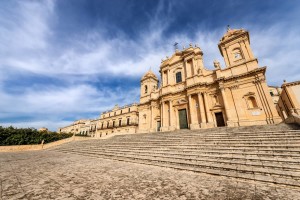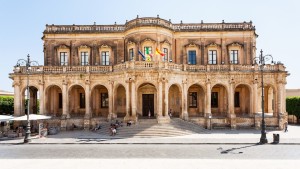The late baroque style is very present and visible in wide parts of Sicily giving the cities and villages a very uniform yet enigmatic look. This cumulation is particularly striking in the Val di Noto, a region endangered by volcanic activities. Eight cities were declared World Heritage Site in 2002 including the particularly charming city of arts Noto. A complete rebuild after a devastating earthquake created the contemporary, fairly homogenous cityscape with a few modern touches and some remains of the rich ancient heritage. Your tour of the orthogonal road grid leads you past numerous tufa buildings and shows you some of probably the most beautiful examples of Sicilian architecture.
A tale of two Notos
Before Noto there was Netum, a sizeable ancient town approx. eight kilometres northwest of today’s city of arts. Founded by the Sicels and conquered by Syracuse rather early, the Romans gave the town to Hiero II of Syracuse, a key figure during the First Punic War, before eventually falling completely under Roman rule. You probably won’t be surprised to find out that Sicel, Greek and Roman structures and artefacts were found in this region. Noto became one of the most important places on the entire island during Arab rule and was Italy’s last Muslim bastion in 1091 before the Normans brought their wealth to town.
The town of notable intellectual figures experienced a devastating turning point on 11 January 1693 when a severe earthquake hit the Val di Noto. Medieval Noto disappeared almost completely, more than half the population was killed. It was decided to rebuild the city on the left shore of the Asinaro river, a bit closer to the coast. City architect Rosario Gagliardi oversaw the contemporary octagonal road grid and the uniform Sicilian baroque style. That’s why the city of arts Noto now has this almost consistent look throughout.
The churches

©Bigstock.com/Alberto SevenOnSeven
It probably goes without saying that plenty of churches were among the numerous buildings constructed after the earthquake. There even were plans to make the city of arts Noto into a diocese, and these house of prayer drove this suggestion:
- San Nicolò: The city of arts’ cathedral is Noto’s largest and most famous church without a doubt. Initially built as a main parish church and greatly expanded during the 18th century, you can see the almost shining façade made of pale yellow limestone from afar. The ostentatious towers and the wide perron give the cathedral a grand presence. As a stark contrast, the interior seems fairly pale ever since the cupola and the side aisles collapsed in 1996 due to material fatigue and erosion. The cathedral has since been renovated extensively with new frescoes added to the rebuilt cupola.
- Santissimo Salvatore: This combination of church and Benedictine convent is comparatively simple yet practical. One thing that stands out is the balcony with iron grillwork that allows the nuns of the convent to follow mass with a view of the piazza in front of the building. These days, the convent is for seminarists only.
- San Carlo al Corso: The concave façade alone makes this church with adjacent Jesuit seminar and monastery an eye-catcher. The classic composition of pillars and capitals skilfully utilises Doric, Ionic and Corinthian elements. Ostentatious paintings, statues and frescoes line the richly decorated interior.
- San Domenico: This church, too, stands out due to the stylistic plurality of its pillars using Doric and Ionic characteristics to playfully support Gagliardi’s masterpiece. The extensive, magnificent stucco of San Domenico depicting various biblical scenes perfectly fits the presentation.
- San Girolamo: Also known as Chiesa di Montevergine, this building was originally established for Benedictine nuns. Another concave façade creates a rather imposing effect due to the rather narrow corridor outside the church. Let yourself be enchanted one more time by opalescent stucco.
More sights in Noto

©Bigstock.com/vvoevale
That’s merely an extract of the numerous churches in the city of arts Noto. However, we want to check out some other buildings you should stop by during your city walk.
- Palazzo Ducezio: Named after the Sicel leader Ducetius, this palace currently houses city hall. The palazzo was visibly inspired by French palaces, the Louis-Quinze-style furniture adds a touch of rococo to the entire presentation. The balcony outside the assembly hall grants you a direct view of the cathedral.
- Palazzo Nicolaci: Noto is all about the Infiorata between late May and early June. Creating these complex flower carpets and paintings on streets and staircases takes weeks and months. Its main presentation site is Palazzo Nicolaci with 90 abundantly decorated rooms. The palace is also home to the city library.
- Museo Civico: Noto’s city museum is divided into two section. On the one hand, you get thrilling insights into regional history with numerous finds from the archaeological complex. The other fascinating section concerns the contemporary art gallery introducing you to Sicily’s more recent art history.
Netum and Villa Romana
Most of Noto’s ancient structures are covered by the ruins of the destroyed medieval town except for three chambers carved into rock. Excavations in the hinterland unearthed rather interesting finds, such as Christian and Byzantine catacombs, and Sicel and Greek cemeteries. Ruins of an amphitheatre, a gymnasium and a Greek inscription hinting at Hiero II of Syracuse were discovered in Netum or Noto Antica, as the old ancient town is called.
You can find even more witnesses to Noto’s ancient heritage. There’s Elorus or Helorus, an ancient Greek town at the coast and the estuary of the river Tellaro, some eight kilometres to the south. Greek ceramics confirm that Elorus was founded around the 8th century BC. Temples, roads, residential buildings as well as evidence of two square towers and a wall ring were discovered here. Travel another kilometre south and stop by Villa Romana del Tellaro, a Roman villa from the second half of the 4th century AD. It is best known for its excellently preserved floor mosaics that might remind you of Villa Romana del Casale.
The rather uniform appearance of the city of arts Noto masks fascinating smaller and larger masterpieces and insider tips that absolutely need to be explored. This UNESCO World Heritage Site is a little bit different in the best way possible introducing you to the complete splendour of Sicilian baroque style. Add exciting traces of the ancient heritage, especially in the hinterland, to the mix and find a gripping, absolutely thrilling destination presenting you with many a treasure hidden behind the fairly homogenous façade. The city of arts Noto is a must-visit destination when travelling to Sicily!